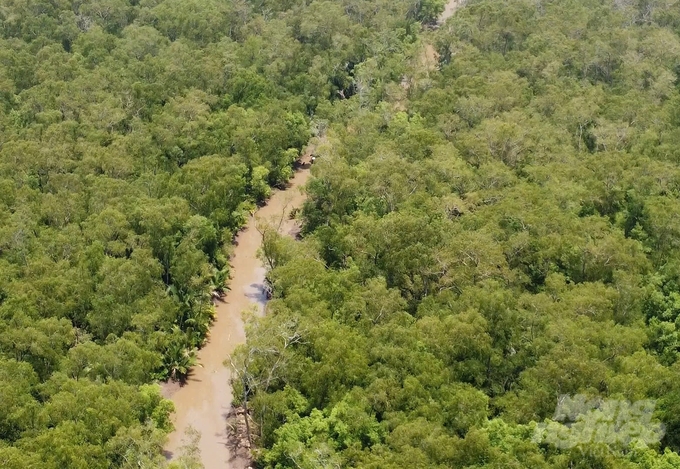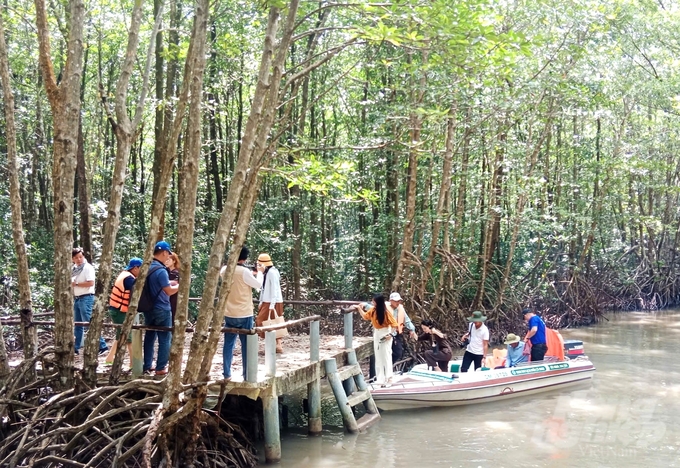November 22, 2025 | 22:13 GMT +7
November 22, 2025 | 22:13 GMT +7
Hotline: 0913.378.918
November 22, 2025 | 22:13 GMT +7
Hotline: 0913.378.918
U Minh Ha National Park (Ca Mau province) was recognized by UNESCO in 2009 as one of the three core areas of the Ca Mau Cape World Biosphere Reserve.
This is a typical melaleuca forest ecosystem on peatland in the Mekong Delta region, serving as a model for melaleuca forest restoration in wetlands. Besides, U Minh Ha National Park also holds significant cultural and historical values preserved over various periods.

U Minh Ha National Park is one of the most notable conservation areas for Melaleuca forests on peatland in the Mekong Delta, with very high biodiversity. Photo: Trung Chanh.
According to Mr. Le Thanh Dung, Deputy Director of U Minh Ha National Park, the park covers a total area of nearly 8.528 hectares, of which more than 1,700 hectares are natural forests. The park is divided into three functional zones: a strictly protected area, an ecological restoration area, and an administrative service area.
U Minh Ha National Park is highly diverse, with 176 species of plants, 23 species of mammals, 91 species of birds, 37 species of fish, and 47 species of amphibians and reptiles. Several species listed in the Vietnam and global Red List can be found here, such as the Java pangolin, fishing cat, smooth-coated otter, long-tailed macaque, king cobra, lesser adjutant, and Malayan night heron. Additionally, some economically valuable freshwater fish species inhabit the park.
Conserving the biodiversity of U Minh Ha National Park means protecting the unique melaleuca forest ecosystem on peatland in the Mekong Delta, with a focus on preserving cultural and historical values, while restoring and maintaining vegetative cover. However, conservation does not mean “closing the door” but rather the current approach is “conserving for development and developing for better conservation”.
To contribute to forest protection and development, especially enhancing the economic value of the forest, the People's Committee of Ca Mau province has approved the ecotourism development Plan for U Minh Ha National Park. This plan aims to develop ecotourism while conserving and developing the melaleuca forest ecosystem, preserving landscapes, and protecting the environment.
The focus is on developing tourism products such as a wildlife and medicinal plant garden, the melaleuca forest ecosystem, forest village models, cuisine, and relaxation activities. There are also efforts to connect the park with other tourism sites within and outside the province, such as Hon Da Bac and Trem river ecotourism, as well as community tourism households.

Developing ecotourism in U Minh Ha National Park will create economic potential for forest protection and development while connecting with other tourism routes within the province, thereby promoting socio-economic development. Photo: Trung Chanh.
According to Mr. Le Thanh Dung, the park is gradually implementing the contents of the ecotourism development plan through 2030. The park follows the principle of developing tourism for conservation, ensuring that tourism activities do not affect the forest ecosystem. Additionally, the park implements a benefit-sharing mechanism with the buffer zone communities to collectively protect the unique Melaleuca forest ecosystem of U Minh Ha. Ensuring income and stable livelihoods for local residents is one of the key aspects of forest protection and biodiversity conservation.
Additionally, the park implements a benefit-sharing mechanism with the buffer zone communities to collectively protect the unique melaleuca forest ecosystem of U Minh Ha. Ensuring income and stable livelihoods for local residents is one of the key aspects of forest protection and biodiversity conservation.

U Minh Ha National Park, as one of the three core areas of the Ca Mau Cape World Biosphere Reserve, has great potential for ecotourism development, attracting tourists for sightseeing, experiencing, and scientific research. Photo: Trung Chanh.
The Park will strengthen its links with local communities to diversify tourism products, building offerings that reflect the cultural identity of each local community. The park is also calling for organizations, individuals, and domestic and international projects to support technical infrastructure for local community tourism. Along with this, efforts will be made to promote tourism and establish local livelihood models in buffer zone communities.
Moreover, based on the benefit-sharing mechanism, U Minh Ha National Park will seek support from various organizations and individuals through community livelihood development projects, aimed at improving the lives of buffer zone residents. This is also a way to raise awareness and responsibility within the community for better conservation and sustainable development of the forest ecosystem in U Minh Ha National Park in the future.
The initiative to lease forest environments for tourism development, particularly ecotourism, scientific research, and forest resource conservation combined with under-forest economic activities, is considered an effective solution for forest protection and development.
Translated by Kieu Chi

(VAN) Results from the Sustainable Durian Model Project in Dak Lak have confirmed the critical role of Yara Viet Nam in transferring advanced nutritional solutions to farmers.

(VAN) In Tuyen Quang province, livestock farmers have introduced effective models and innovative practices that significantly strengthen African Swine Fever prevention and control efforts.

(VAN) This is the study conducted by IRRI and Can Tho University on the rice straw value chain in Mekong Delta showing an economic potential of more than 6.6 trillion VND/year.

(VAN) By participating in cooperative economics, many farmers in Tay Ninh have overcome hardship, mastered clean dragon fruit cultivation techniques.

(VAN) The crossbreeding program in the former Binh Dinh province (now part of Gia Lai) has shown signs of decline, and urgent measures are needed to revive it and sustain past achievements.

(VAN) The agricultural sector agreed on a roadmap to pilot the MRV protocol and expand low-emission rice production from the 2025-2026 winter-spring crop.

(VAN) Agricultural extension officers in Quang Ninh do more than transmit knowledge; they have become a steadfast support system for farmers on the path to sustainable agricultural development.